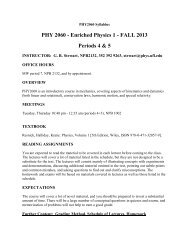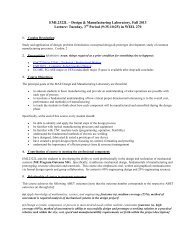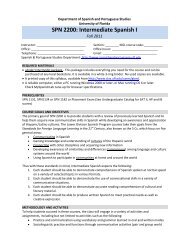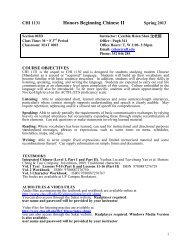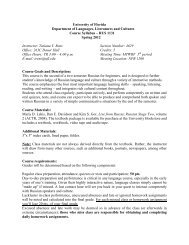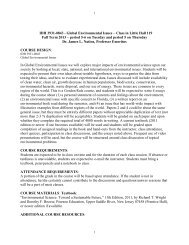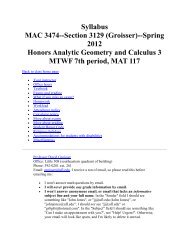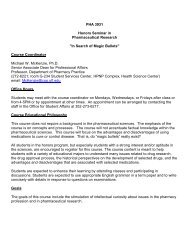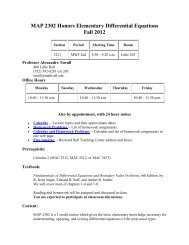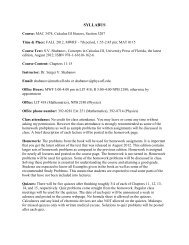IDH3931 HNR Read Music Archital Zach - University of Florida ...
IDH3931 HNR Read Music Archital Zach - University of Florida ...
IDH3931 HNR Read Music Archital Zach - University of Florida ...
- No tags were found...
Create successful ePaper yourself
Turn your PDF publications into a flip-book with our unique Google optimized e-Paper software.
IDH 3931 (Un)Common <strong>Read</strong>ing: Sound and Space in Renaissance VeniceSection 0727Fall 2013Honors Department<strong>University</strong> <strong>of</strong> <strong>Florida</strong>Meeting Time: T 7Place: MUB 142Credit Hours: 1Pr<strong>of</strong>essor Dr. Miriam <strong>Zach</strong>Department <strong>of</strong> Honors, <strong>University</strong> <strong>of</strong> <strong>Florida</strong>E-mail: minerva@ufl.eduMail Box: <strong>Music</strong> Main Office 130with Pr<strong>of</strong>essor Dr. Mikesch MueckeDepartment <strong>of</strong> ArchitectureCollege <strong>of</strong> DesignIowa State <strong>University</strong>, Ames, IA 50011E-Mail: polytekton@gmail.comCOURSE DESCRIPTION AND OBJECTIVESThe book Sound & Space in Renaissance Venice by Deborah Howard (Cambridge) and LauraMoretti (Oxford), published by Yale <strong>University</strong> Press (2009/2010), reunites the aural and visualdimensions <strong>of</strong> sacred music and architectural design in 16th-century Italy. The book and onlineinteractive website combines historical research with results <strong>of</strong> scientific studies <strong>of</strong> acousticproperties <strong>of</strong> Venetian churches, including the well-known San Marco and in hospitals. Duringthe 16th-century Venice was the creative center <strong>of</strong> explorations in choral polyphony that led topioneering developments in the evolution <strong>of</strong> stereophonic sound <strong>of</strong> Giovanni Gabrieli andMonteverdi within the spaces created by architects such as Sansovino and Palladio.This fascinating book is the result <strong>of</strong> interdisciplinary collaboration by an international group <strong>of</strong>scholars in three disparate disciplines: architectural history, musicology and acoustics at the<strong>University</strong> <strong>of</strong> Cambridge, England, with recorded choral experiments by the St. John’s CollegeCambridge men and boy’s choir who were able to sing complex Renaissance polyphony at sight.Course objectives are to learn about the advantages and pitfalls <strong>of</strong> interdisciplinary work throughthe lens <strong>of</strong> two apparently opposite disciplines: music as the most ephemeral, non-material art,and architecture, the most concrete and material-based. Classes are organized around instructorbasedlectures, student-initiated discussions, and short campus-based field excursions to relevantsites, augmented by both instructors working as intellectual interlocutors across their respectivedisciplines.REQUIRED READINGDeborah Howard, Laura Moretti. Sound and Space in Renaissance Venice. New Haven, CT: Yale<strong>University</strong> Press, 2009/2010. The book is available for about $30.00-$40.00 onAmazon.com, abebooks.com, and other online retailers.
REQUIRED LISTENINGFrom the “Repertoire for Choral Experiments” in the required book (page 287-299). MP3s canbe downloaded at http://www.yalebooks.co.uk/soundandspaceWe will analyze and organize data within the structure <strong>of</strong> a musicological chart (nationality,composer, title, historical style period, genre, language, medium, and style characteristicsincluding form and extra-musical influences), and journals.ADDITIONAL STUDY MATERIALSAdditional audio-visual materials will be available with your Gator ID for 2 hours in theArchitecture Fine Arts-<strong>Music</strong> Library, and through online links provided by the pr<strong>of</strong>essors.COURSE ASSIGNMENTS AND GRADINGObjectives will be met by attending and actively participating in each class session. E-mail yourwritten work to minerva@ufl.edu and polytekton@gmail.com.The final grade takes into account your creative effort in:Points Task100 One (1) 45-minute in-class Research Presentation including content, organization,delivery, illustrative material including musical examples, and annotatedresource references with ten (10) sources for course colleagues. You HAVE to citeyour sources. E-mail your presentation and reference list to minerva@ufl.edu andpolytekton@gmail.com50 One (1) listening test10 One listening journal (typed, single-spaced) and musicological chart(due at the test: 1 journal + chart = 10 points)Two (2) 2-page essays (typed, double-spaced) reflecting on the research experiences. E-mailyour essays to minerva@ufl.edu and polytekton@gmail.com20 Soundscape: blind walk - lead & be led, play instrument blindfolded, and viewexcerpts <strong>of</strong> film At First Sight.20 Acoustics: explore <strong>University</strong> Memorial Auditorium, Baughman Center, and<strong>Music</strong> Building band room200 Total Possible PointsGRADING CHARTA 191-200 A- 181-190 B+ 171-180 B 161-170 C+ 151-160C 141-150 D 131-140 E 0-130For more information on grading at UF, please see
http://www.registrar.ufl.edu/catalog/policies/regulationgrades.htmlA You attend class regularly and contribute positively. All assignments are turned in ontime, complete, accurate in content, and presented in a pr<strong>of</strong>essional manner. Combined gradeaverage on the test, assignments and class presentation is A or close to it.B You complete all required assignments but one or more <strong>of</strong> the following may apply:(1) assigned work is mostly but not consistently thorough, accurate, or <strong>of</strong> high quality,(2) attendance and class involvement is inconsistent, and (3) the presentation and test scores are aB or C.C You complete most <strong>of</strong> the required assignments but one or more <strong>of</strong> the following mayapply: (1) the quality <strong>of</strong> the work is generally marginal, (2) the presentation and test scores areno higher than a C, and (3) attendance and class participation is irregular.D One or more <strong>of</strong> the following may apply: (1) all assignments are not completed or are <strong>of</strong>mostly poor quality, (2) presentation and test scores are below a C, (3) attendance and classparticipation is poor.EMost course requirements are NOT met satisfactorily.ATTENDANCEObjectives will be met by attending and actively participating in each class session. You areexpected to attend all course meetings and sign your name on the course attendance sheet at thebeginning <strong>of</strong> each class. You are accountable for material covered in lectures and discussion.If you miss class, it is your responsibility to find out what you missed. If you must miss a classdue to an excused absence (religious, health-related, or participation in an approved academic orathletic event) you should contact the instructor with a written excuse in advance, wheneverpossible.NOTES1. Students with disabilities requiring academic accommodations should 1) register with andprovide documentation to the Disability Resource Center in 001 Reid Hall within the first twoweeks <strong>of</strong> class and 2) bring a letter to the pr<strong>of</strong>essor from DRC indicating what type <strong>of</strong>accommodation you need. Syllabi and other class materials are available in an alternative formatupon request. For further information, call (352) 392-8565, email mailto:accessuf@dso.ufl.eduor visit the DRC web site http://www.dso.ufl.edu/drc/.2. All students will be held to the UF Student Honor Code. If you have any questions about whatconstitutes academic honesty and ethical conduct at UF, please consult the UndergraduateCatalog at the Registrar’s Office http://www.registrar.ufl.edu/catalog/policies/students.html.Caveat: The procedures and schedule are subject to change in the event <strong>of</strong> extenuatingcircumstances.



